|
setSC-Pholisma_sonorae-6
|
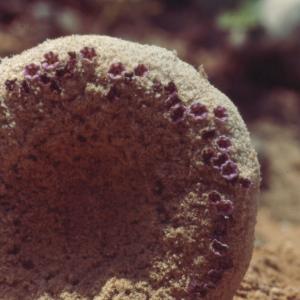
|
A somewhat younger inflorescence of Pholisma sonorae, removed from the sand, with the sand shaken from the center. The flowers are lavender in color. Perhaps one should say heliotrope colored, because Pholisma sonorae is now considered a member of the Boraginaceae, sometimes known as the heliotrope family.
Return to the Pholisma sonorae page or the Parasitic Plant Index.
|
copyright: Carlquist, BSA
license: http://images.botany.org/index.html#license |
Image
|
Parasitic Plants

|

|
|
setSC-Pholisma_sonorae-7
|
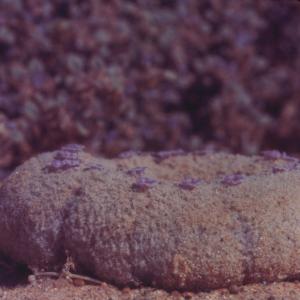
|
A view of an Pholisma sonorae inflorescence from the side. Flowers are visible on the along the edge.
Return to the Pholisma sonorae page or the Parasitic Plant Index.
|
copyright: Carlquist, BSA
license: http://images.botany.org/index.html#license |
Image
|
Parasitic Plants

|

|
|
setSC-Pholisma_sonorae-8
|
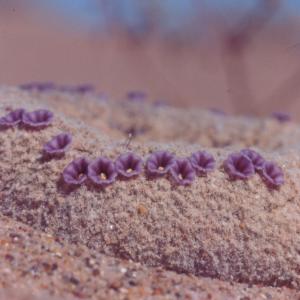
|
A view of an inflorescence of Pholisma sonorae from the side. Notice that the hairs of the inflorescence, from which the flowers emerge, are the same tan color as the sand in which Pholisma sonorae grows. This color may prevent Pholisma sonorae eaten by desert herbivores. Herbivores tend to avoid plants that are excessively hairy.
Return to the Pholisma sonorae page or the Parasitic Plant Index.
|
copyright: Carlquist, BSA
license: http://images.botany.org/index.html#license |
Image
|
Parasitic Plants

|

|
|
setSC-Pholisma_sonorae-9
|
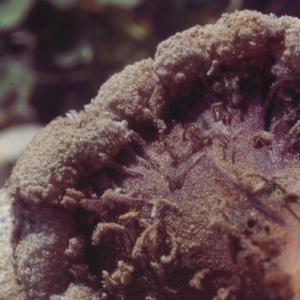
|
An inflorescence of Pholisma sonorae removed from the sand and positioned so that the lower side and rounded edge of the funnel-shaped inflorescence are visible. The funnel-shaped inflorescence tapers into the stalk (not shown) which would be at lower right. Notice the small reduced leaves on the lower (outer) side of the inflorescence.
Return to the Pholisma sonorae page or the Parasitic Plant Index.
|
copyright: Carlquist, BSA
license: http://images.botany.org/index.html#license |
Image
|
Parasitic Plants

|

|
|
setSC-Pinguicula_caerulea-5
|
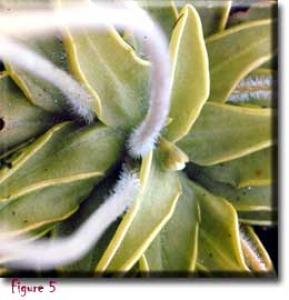
|
Here are the leaves of Pinguicula caerulea, seen from the above. The bases of three flower stalks can be seen. Pinguicula caerulea occurs in the southeastern United States.
|
copyright: Carlquist, BSA
license: http://images.botany.org/index.html#license |
Image
|
Carnivorous Plants

|

|
|
setSC-Pinguicula_caerulea-6
|
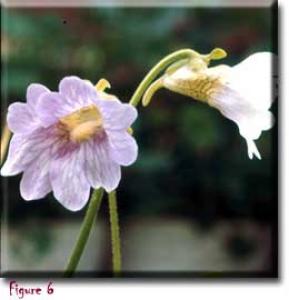
|
The flowers of Pinguicula caerulea are bluish-purple (the word caerulea means "sky-blue" in Latin). Here one flower is seen from the front, one from the side. Notice the small spur on the flower seen in side view. As with Pinguicula lutea, the flowers of Pinguicula caerulea are wide enough to admit a bee, and a long-tongued bee can, when it fully enters the flower, suck nectar from the spur.
|
copyright: Carlquist, BSA
license: http://images.botany.org/index.html#license |
Image
|
Carnivorous Plants

|

|
|
setSC-Pinguicula_caerulea-7
|
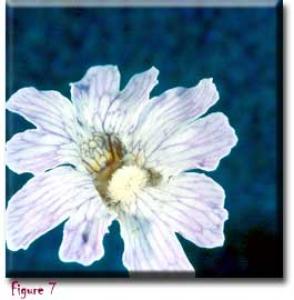
|
The flower of Pinguicula caerulea, seen from the front, features deep blue-purple veins on a white background. Patterns like this tend to be asociated with be pollination. Where they are, such patterns are called guidelines, because bees are programmed to follow the direction of the veins, which lead them into a flower.
|
copyright: Carlquist, BSA
license: http://images.botany.org/index.html#license |
Image
|
Carnivorous Plants

|

|
|
setSC-Pinguicula_caerulea-8
|
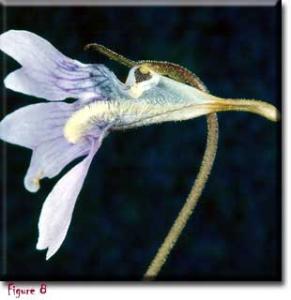
|
A section through a flower of Pinguicula caerulea shows the passage from outside to inside. The furry lump on the lower side of the throat evidently is a signal to a bee that it is on its way toward nectar, and tells it which is the lower side of the flower. If a crawled into the flower with the fury lump below, its back would be contacted by the anthers, which dust pollen on its back (an indentation on the upper part of the tube of the flower, on its upper side) or by the flower's stigma, which picks up pollen. Then a long-tongued bee could get nectar from the spur, which is too narrow for a bee's head but not its tongue.
|
copyright: Carlquist, BSA
license: http://images.botany.org/index.html#license |
Image
|
Carnivorous Plants

|

|
|
setSC-Pinguicula_lutea-1
|

|
Here we see a butterwort, Pinguicula lutea, in its native habitat near Jacksonville, Florida. Pinguicula lutea occurs in sunny, open, wet areas throughout the southeastern U.S. Although butterworts have leaves and therefore trapping mechanisms that look nothing like those of the bladderworts (Utricularia), the two belong to the same family (Lentibulariaceae). Pinguicula bears one or two flowers at the end of a long stalk.
|
copyright: Carlquist, BSA
license: http://images.botany.org/index.html#license |
Image
|
Carnivorous Plants

|

|
|
setSC-Pinguicula_lutea-2
|
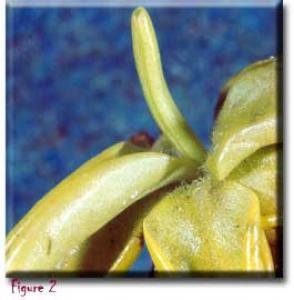
|
The leaves of Pinguicula lutea seen up close, bear short hairs, (seen at the base of the lower leaf) which secrete sticky mucilage. Invisible in the shiny surface of the picture are tiny round glad hairs that digest insects that are caught in the mucilage.
|
copyright: Carlquist, BSA
license: http://images.botany.org/index.html#license |
Image
|
Carnivorous Plants

|

|
|
setSC-Pinguicula_lutea-3
|
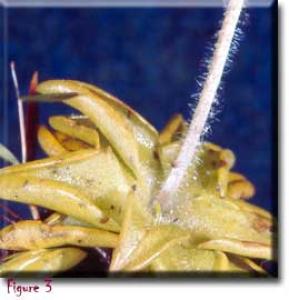
|
The leaves of Pinguicula are yellowish in color, which is probably the source of the common name butterwort. The trapping mechanism of Pinguicula is a simple one. Insects become stuck in the sticky mucilage (which they may mistake for water or nectar). When an insect becomes stuck on the mucilage, the edge of the leaf slowly rolls over. The leaves never completely close. When the insect is digested, the leaf edges unrill and the leaf becomes more nearly flat.
|
copyright: Carlquist, BSA
license: http://images.botany.org/index.html#license |
Image
|
Carnivorous Plants

|

|
|
setSC-Pinguicula_lutea-4
|
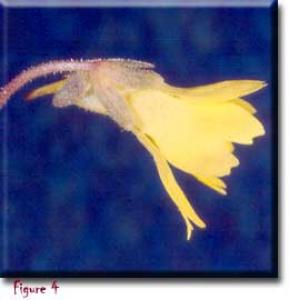
|
The flowers of Pinguicula lutea are bright yellow. This color is attractive to bees. A bee could fit easily into the wider part of the flower of Pinguicula lutea. There is a small pointed tip on the flower, the spur (at left), which contains a droplet of nectar. A bee, properly oriented within the flower, could feed on the nectar if it has a long tongue.
|
copyright: Carlquist, BSA
license: http://images.botany.org/index.html#license |
Image
|
Carnivorous Plants

|

|
|
setSC-Pinguicula_macroceras-11
|
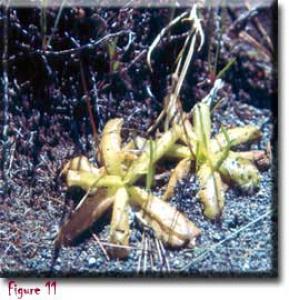
|
Pinguicula macroceras from northern California isn't a conspicuous plant. A butterwort when not in flower can be identified by its sticky yellowish leaves and by its habitat--acid areas that are wet throughout the year. Butterwort plants are perennials, living for several years.
|
copyright: Carlquist, BSA
license: http://images.botany.org/index.html#license |
Image
|
Carnivorous Plants

|

|
|
setSC-Sarcodes_sanguinea-10
|
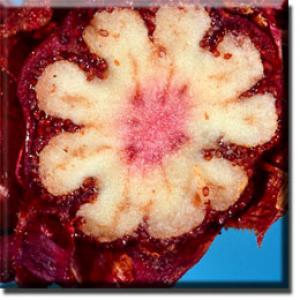
|
|
copyright: Carlquist, BSA
license: http://images.botany.org/index.html#license |
Image
|
Parasitic Plants

|

|
|
setSC-Sarcodes_sanguinea-11
|
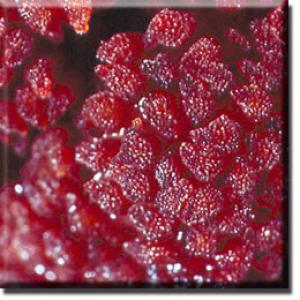
|
|
copyright: Carlquist, BSA
license: http://images.botany.org/index.html#license |
Image
|
Parasitic Plants

|

|
|
setSC-Sarcodes_sanguinea-2
|
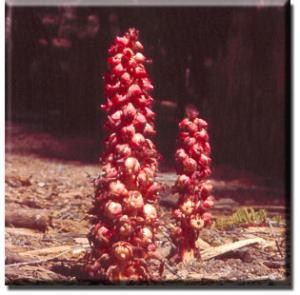
|
There is a group of non-green flowering plants that is related to the heaths (blueberries, cranberries, rhododendrons) and is often included in the heath family (Ericaceae). This group of non-green plants is a subset of the heath family. Let's call them the monotropoids. Are they parasites? Yes, but in an unusual way. The monotropoids were thought to be "saprophytes." A saprophyte lives on dead plant or animal material, but the monotropoids don't do that. They are parasites on fungi, we can call them mycoparasites. But they don't kill the fungi. The fungi infect the short, stubby roots of the monotropoids, and transfer food and water into the roots. The fungi live in the dense litter of dead leaves in wet forests.
|
copyright: Carlquist, BSA
license: http://images.botany.org/index.html#license |
Image
|
Parasitic Plants

|

|
|
setSC-Sarcodes_sanguinea-3
|
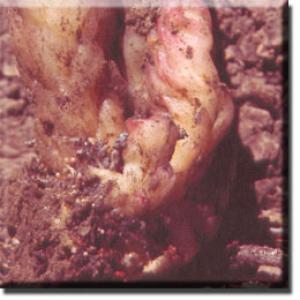
|
|
copyright: Carlquist, BSA
license: http://images.botany.org/index.html#license |
Image
|
Parasitic Plants

|

|
|
setSC-Sarcodes_sanguinea-4
|
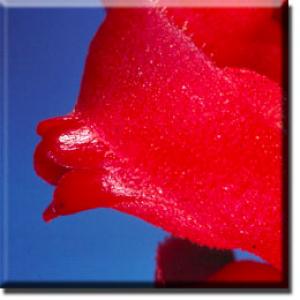
|
|
copyright: Carlquist, BSA
license: http://images.botany.org/index.html#license |
Image
|
Parasitic Plants

|

|
|
setSC-Sarcodes_sanguinea-5
|
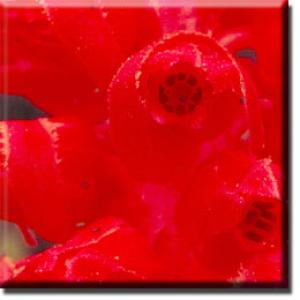
|
|
copyright: Carlquist, BSA
license: http://images.botany.org/index.html#license |
Image
|
Parasitic Plants

|

|
|
setSC-Sarcodes_sanguinea-6
|
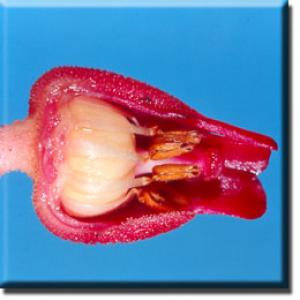
|
|
copyright: Carlquist, BSA
license: http://images.botany.org/index.html#license |
Image
|
Parasitic Plants

|

|